Today, finding the right skilled candidates is more important than ever — especially since we’re heading towards an $8.5 trillion talent shortage, with more than 85 million jobs predicted to be unfilled by 2030.
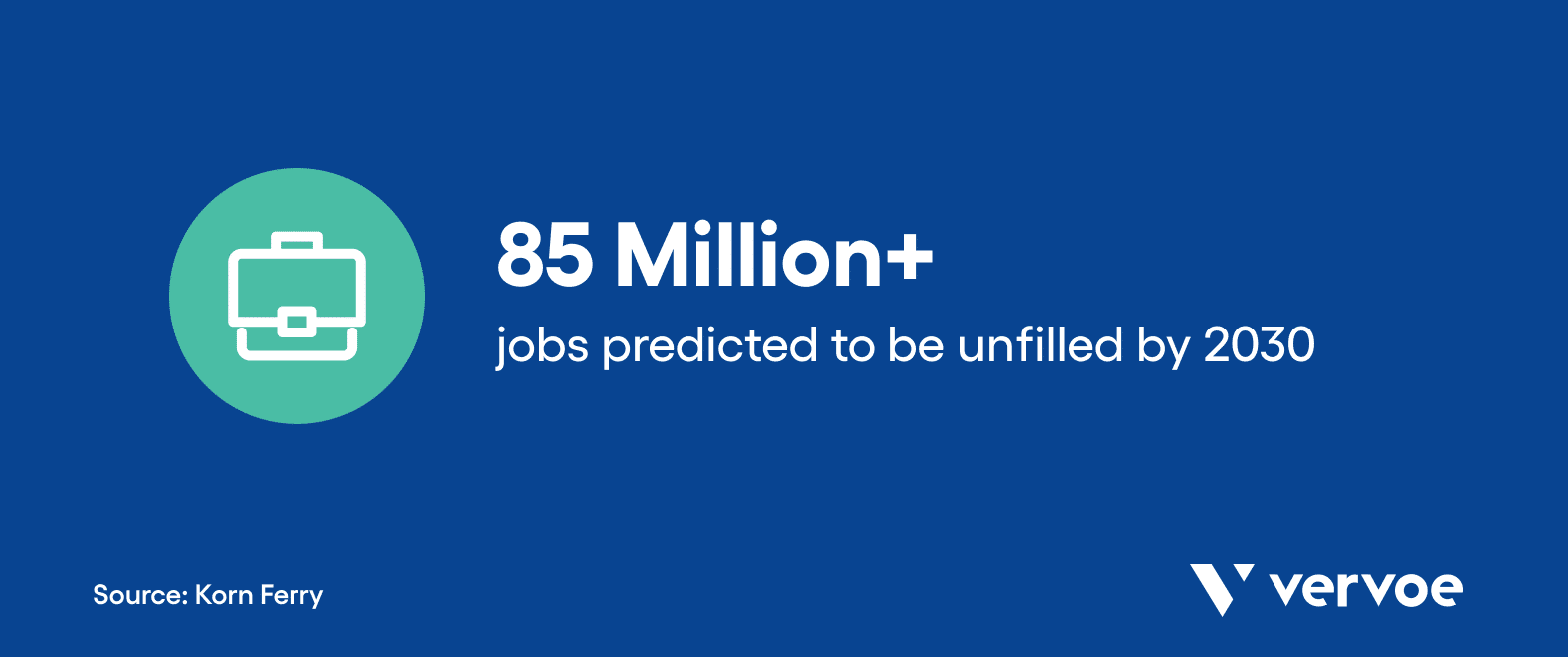
But, what exactly does this mean? The way we advertise, source, and identify top talent is changing. It’s no longer enough to review a CV or run a candidate through a phone interview to determine their suitability; it’s about validating their skills beyond a piece of paper to hire confidently.
Yep, we’re talking about job simulations — the practical hiring tool that allows you to see candidates in a way that a CV can’t: their skills in action.
Wondering what exactly a job simulation is and how it can help you identify top talent more accurately and effectively than traditional recruiting tools? Keep reading!
What is a job simulation test?
A job simulation is a type of pre-employment test used for employee testing and selection. A job simulator test assesses candidates on their ability to perform realistic tasks and duties common to the role they’re applying for. Simply put, job simulations take applicants through a realistic day in the life of the position to assess how their hard and soft skills align with the job’s requirements.
Several types of employee selection tests are used commonly in job simulations — ranging from in-basket, situational judgment tests, work samples, role-playing, take-home assignments, and more.
For example, this might include:
- An applicant for a salesperson position being asked to pitch the company’s product or service in 10 minutes (role-playing simulation)
- An applicant for a graphic design position being asked to design social media artwork for an upcoming product launch (work sample simulation)
- An applicant for a customer service position being asked to deal with a disgruntled customer email by selecting their most and least likely response via a multiple choice question (situational judgment simulation)
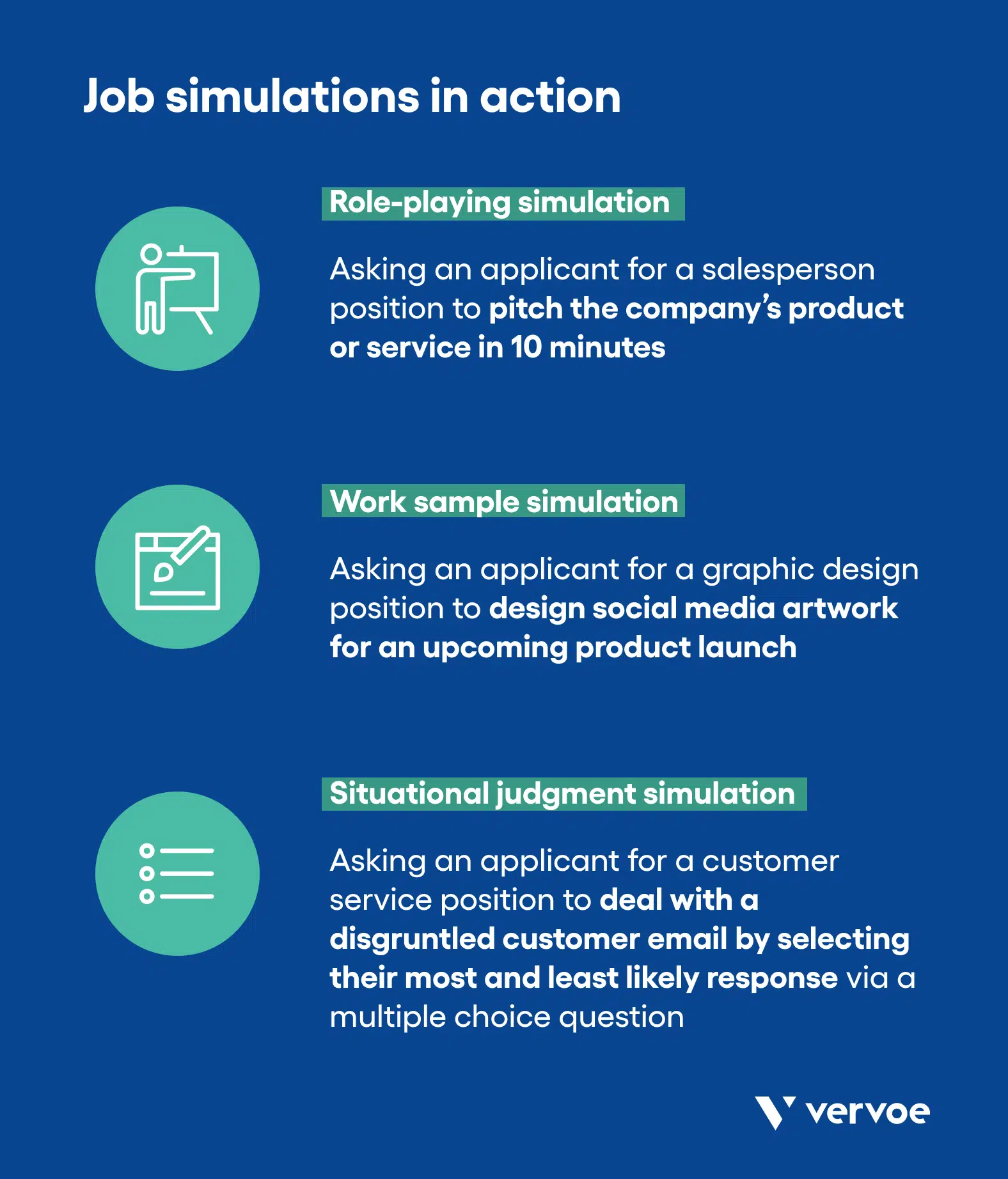
Job simulations have become popular online assessment tools for hiring as they help to accurately predict performance and suitability, particularly compared to resumes and interviews. A job simulation allows organizations to understand which of their applicants has the skills required to succeed in the role while giving candidates a realistic job preview to help them decide if it meets their expectations.
[Read more: The Ultimate Guide to Job Simulations]
Job simulations vs traditional recruitment: why the latter no longer cuts it
Traditional recruitment processes may seem effective in theory. After all, hiring managers are hard at work sifting through resumes or using resume-parsing software to search for keywords. Next, they’re organizing unstructured interviews with the shortlisted candidates, followed by a quick reference check before choosing the assumed top performer.
So, what’s the issue? None of these procedures adequately assess a candidate or predict their performance, resulting in two major problems: the inability to hire top performers and retain great talent.
Over reliance on resume screening
Traditional recruiting processes, such as resume screening, often rely on a CVs contents to assume performance. This means hiring managers are assuming eligibility based purely on a list of experiences and accomplishments — none of which are verified, and none of which showcase a candidate’s complete skills or how they align with your role.
Traditional recruiting lacks effective employee performance methods
Employee performance relies on three core functions: ability, motivation, and personality. Ability refers to cognitive abilities, expertise, and technical skills. Personality refers to their soft skills and will help you understand how they’ll fit culturally within your team dynamic and contribute to collaboration. And lastly, motivation is what drives your employee’s performance.
Unfortunately, the latter is hard to identify with traditional methods, and even the first is difficult to validate. Candidates are much more than just their technical abilities; for an employee to perform well in a role, it’s important to ensure all three areas align with your company and role.
So, what does all of this mean exactly? Traditional recruitment processes:
- Don’t look at all the critical elements that make up a candidate
- Don’t validate a candidate’s skills
- Are riddled with bias, meaning you may not always be hiring the best person for the job
- Are time-consuming and ineffective
6 reasons why job simulations are the best way to identify top talent
1. Job simulations show you what resumes can’t: A candidate’s skills in the context of your role
The unfortunate reality of traditional recruitment practices is that they lack accuracy because they use CVs — i.e., educational background and former experience — as a proxy to determine whether or not one candidate is a better fit than the next.
Today, recruiters and organizations are beginning to understand that this approach does more harm than good. Here’s why:
Resumes are biased
Let’s not forget that resumes are written by the applicant, meaning they’re merely narratives written from their perspective and experience, which can lack accuracy and validation. Generally, bias and selective storytelling will alter the accuracy of the information used to predict top performers.
Likewise, they may demonstrate an applicant’s job history, but they tell you very little about a person’s skills, character, and suitability for your role and company.
Resumes contain embellished (and often untrue) information
Fine, we said it: it’s not uncommon for candidates to lie on their resumes. And it’s not just us saying it. According to a 2017 report, almost 85% of employees revealed that applicants lie on their resumes or applications, often exaggerating their experience or skills.
These findings are corroborated by a 2022 ResumeLab study to a lesser extent, which found that 36% of Americans admit to lying on their resumes:
- 27% lie about experience
- 18% lie about their skills
- 17% lie about job duties
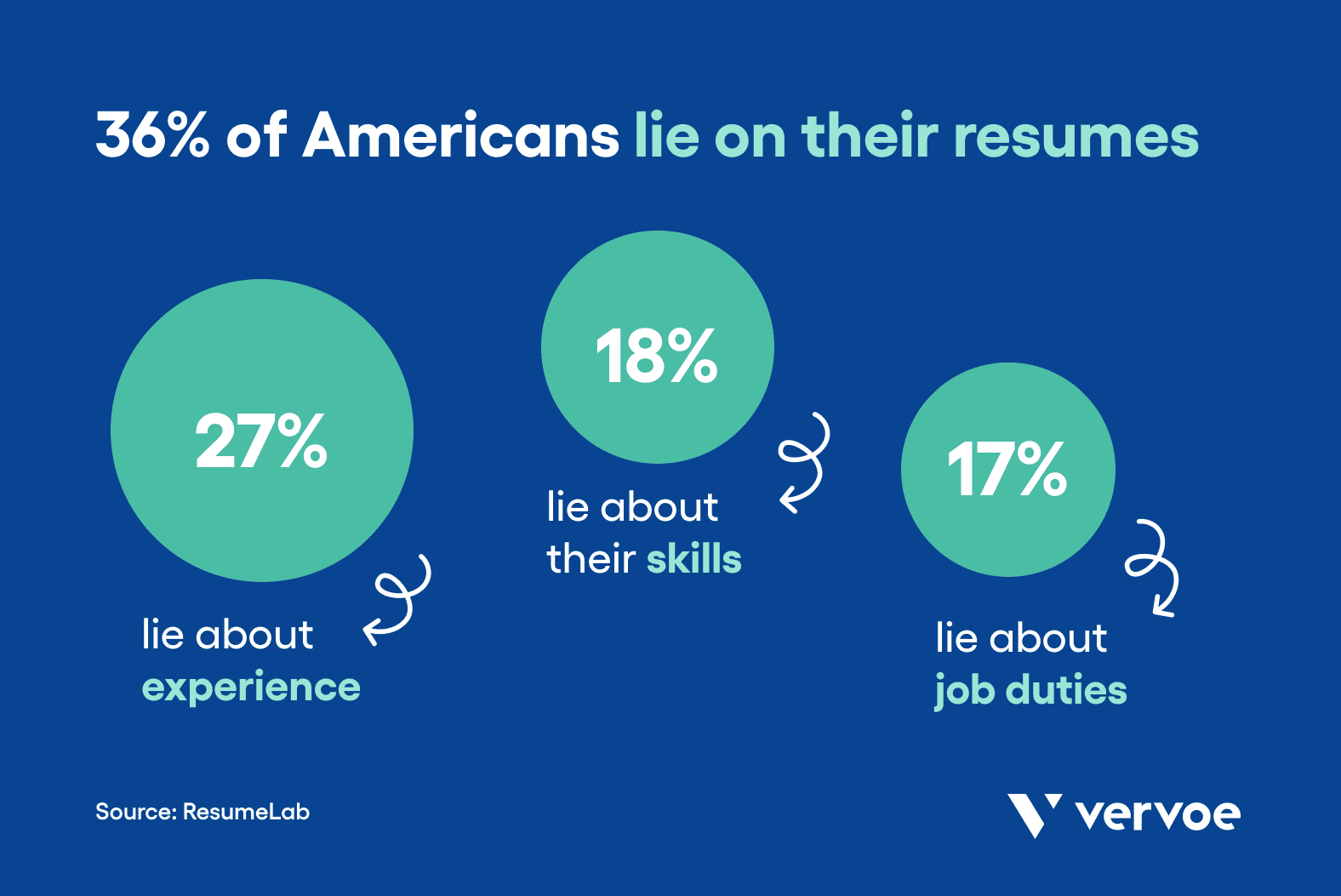
This means that what many recruiters rely on to form important decisions about a candidate’s suitability are potentially falsehoods. For example, let’s take Yahoo’s former-CEO Scott Thompson.
Thompson was hired based on the qualifications and accomplishments outlined on his resume, which were later discovered to be lies. He got all the way to the top of one of the world’s most iconic tech companies without anyone validating some of the biggest claims on his resume.
Resumes don’t indicate how a candidate will perform in your company
The most effective way to see how a candidate will perform in your role is to see them do it before they get the job. However, resumes are simply historical documents that briefly outline how an applicant has performed in other companies and positions, not yours. They don’t predict or project future performance, giving you minimal indication of whether they are suitable.
For example, let’s refer back to Scott Thompson quickly. While lying may not have been the best approach, this example reiterates that skills in action speak louder than words on a resume. For Thompson to succeed to the CEO level without having the qualification he claimed to have had, it suggests his performance was clearly adequate.
2. Job simulations give you deeper insight into a candidates hard skills
Hard skills refer to technical capabilities a candidate has gained through experience, whether in their career, college, or self-teaching. This might include skills such as graphic design, accounting, coding, copywriting, and so forth.
Every role and company will require a unique combination of skills — made up of both hard and soft skills. Yet, while a resume will merely list what hard skills a candidate may possess based on their previous experience and education, a job simulation will validate said skills by showing you how they look in practice.
Any technical knowledge or training gained through work experience, self-teaching, or education is considered a hard skill. For example, this might include:
- A designer that has studied or self-taught skills in Adobe design programs.
- Warehouse staff who have experience using an RF or barcode scanner.
- A software developer who can write code in a particular language.
- A content marketing manager with video editing skills.
Unlike seeing a list of supposed hard skills on a resume, a job simulation allows you to see those skills in the context of your role, particularly the everyday duties that make up a fundamental part of the job. For example, suppose you’re interviewing candidates for a Data Analyst position where you want to assess candidates on hard (aka technical) skills such as data models and data classification. In that case, a job simulation could include the following questions:
- Data models: What, according to you, will happen as the complexity of a model increases?
- Data classification: You are working on a sentimental analysis project which classifies text as positive, negative, or neutral. The label you are trying to predict, described by the other features (here, input text), is known as?
3. Job simulations reveal a candidates true soft skills
It seems not all that long ago organizations were only interested in how an applicant’s technical skills aligned with their role and company goals. Fast forward to the current recruitment climate, and hiring managers globally understand the significance of ensuring candidates have the right soft skills to succeed in a role and company.
Consider the following statistics on the importance of soft skills in the workplace:
- According to LinkedIn’s 2019 Global Talent Trends report, 89% of recruiters believe that a bad hire generally comes down to a lack of soft skills
- When asked to identify the most important skills they look for in employees, most employers reference soft skills, including dependability, collaboration, flexibility, and problem-solving, according to The Future of Work 2021: Global Hiring Outlook report
- A 2021 America Succeeds study analyzed data from 82 million job postings, finding that the top five soft skills were requested nearly 4x more than the top five hard skills
- 92% of talent professionals reported that soft skills are equally or more important to hire for than hard skills, according to LinkedIn’s Global Talent Trends report
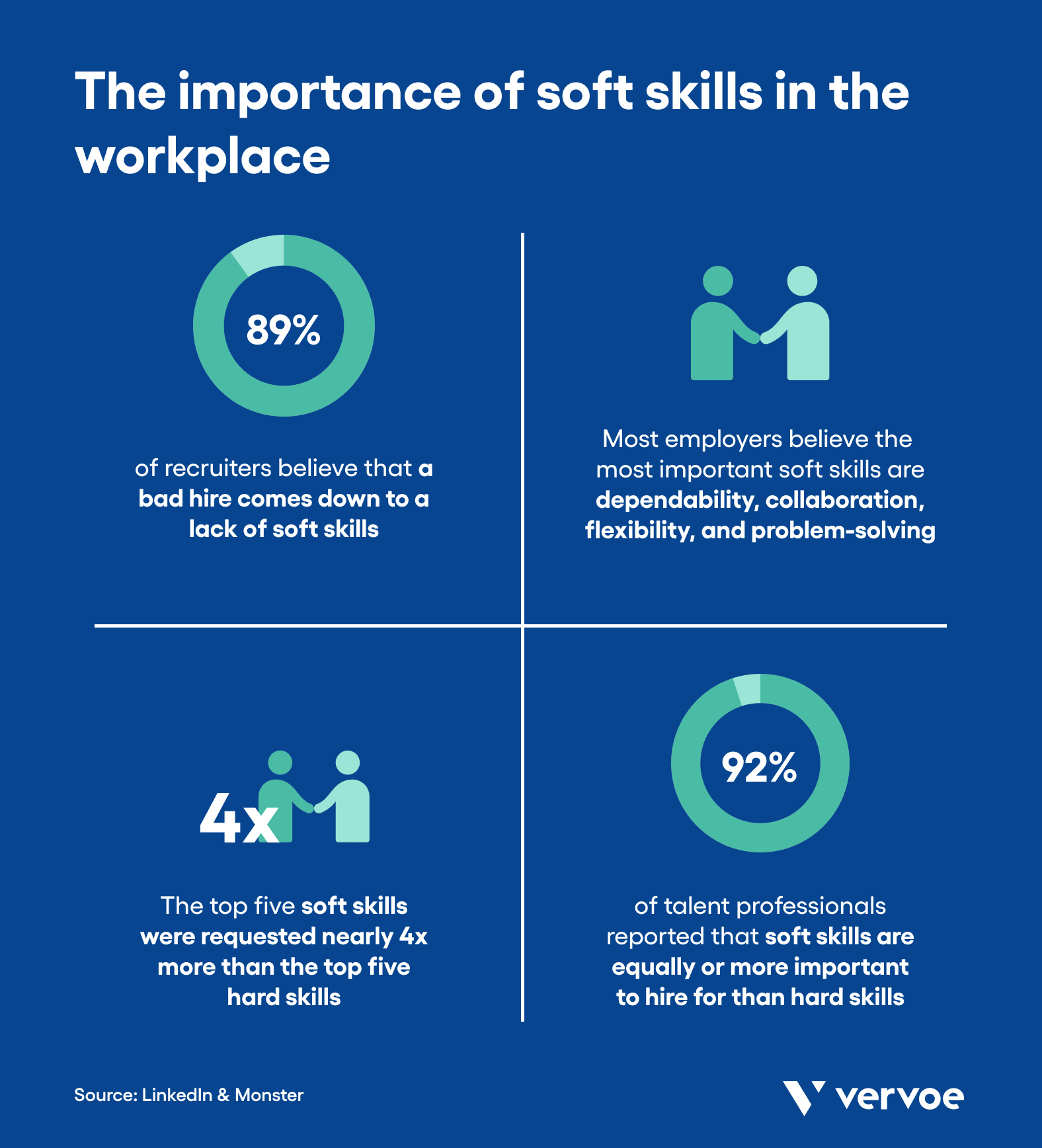
Hard and soft skills are two fundamental aspects of understanding a candidate’s skills, motivation, and personality. Businesses are recognizing the importance of finding a balance between hard and soft skills, understanding how an employee operates and what inspires them is just as important as having the right knowledge and skills to get the job done. Yet, many traditional recruitment practices still prioritize evaluating candidates based on their technical skills — meaning they aren’t seeing the whole picture when assessing a candidate’s suitability for a role.
The importance of paying attention to soft skills
The end result? Without an adequate understanding of a candidate’s capabilities and characteristics, employers are likelier to make poor hiring decisions with long-term consequences — such as poor performance, impacted team morale, high retention rates, and higher expenses allocated to re-hiring.
The business benefits of assessing soft skills are undeniable. Here are just a few reasons employers — including Amazon, Xerox, and Tesla — are prioritizing soft skills in their hiring practices:
- Positive work culture is closely linked to employee retention — A Columbia University study found that organizations with a positive company culture had a low job turnover rate of 14%. In comparison, those with a poor company culture had a turnover rate of more than 3x that (48%)
- Many studies have found a clear link between company profit and leadership teams with high emotional intelligence — According to one study, employees who rated their CEOs ‘high in character’ had a 5x higher average return over two years than companies with CEOs who had low character ratings
- Advancements in AI are causing a positive shift towards hiring for soft skills — To counteract the skills that machines are a long way from mastering, McKinsey predicts that the need for finely tuned social and emotional skills (i.e., people skills) will rapidly increase by 2030
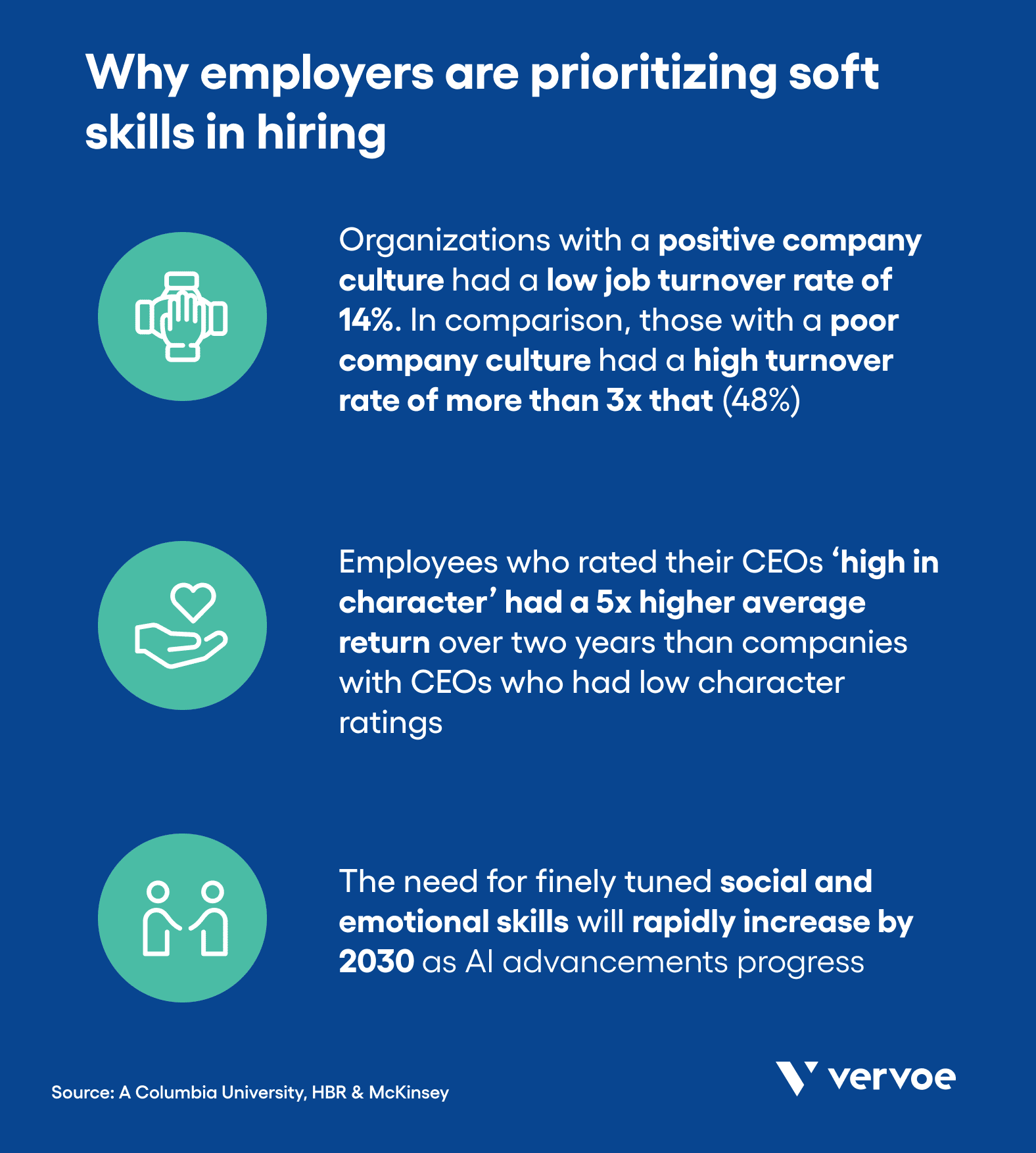
[Read more: Hard Skills vs. Soft Skills: Which is More Important]
When selecting the most qualified candidate, there’s no recruitment method more accurate or predictive of performance than a job simulation. A job simulation mimics the responsibilities and duties of the role, putting candidates in a scenario that accurately reflects a day on the job — assessing both hard and soft skills. Doing so gives you greater insight into a candidate’s capabilities, characteristics, and thought processes, allowing organizations to see how they’d perform and contribute to the company culture and in different work situations.
Unlike traditional recruitment processes that rarely identify and assess candidates on their soft skills, job simulations ask intentional questions that look to test both technical and soft skills. Take, for example, the following sample questions from Vervoe’s Data Analyst and Product Manager Assessments:
- Data Analyst role: Describe a time when you have had to make a decision without having all of the necessary information. How did you come to a decision? (testing critical thinking)
- Product Manager role: Imagine you are successful in this role and need to communicate a new feature for your product to the sales team. How would you ensure that each sales team member understands the new feature correctly? (testing communication)
- Product Manager role: Imagine that you have joined a company that is currently using multiple platforms to manage customer data, and it’s time-consuming for your team. What would be your strategy in finding a fit-for-purpose CRM platform to help consolidate the tech stack? (testing collaboration)
4. Job simulations widen your talent pool
When done right, job simulations can widen your talent pool, giving you instant access to more potential top performers — improving the volume of candidates you have access to and the diversity of your talent pool.
To understand how this is possible, it’s essential to take a quick look at how many traditional recruitment processes work and where they implement barriers for candidates along the way. Consider the following conventional recruitment process:
- Post a job listing — An organization or recruiter will create a job post with a list of requirements and responsibilities — often based on assumed knowledge, former experience, and educational requirements.
- Screen candidates — The recruiter or organization will use screening tools and tactics to look for keywords on a candidate’s application to assess if the candidate meets the requirements (i.e., by evaluating former experience, qualifications, or education). Or, they may manually review all applications.
- Interview shortlisted candidates — Once they’ve identified who they assume are the most suitable candidates, organizations will often follow up with an interview to ask further questions and get a feel for their personality. Often, traditional hiring practices lean on an unstructured interview process, which contains bias, lacks consistency, and isn’t a fair measure of a candidate’s capabilities.
What is the issue with the process above?
- It includes many unnecessary requirements that aren’t indicative of success — i.e., the candidate must have three years of experience in a similar role and a Bachelor’s Degree in Economics.
- It automatically eliminates many candidates from diverse backgrounds — i.e., those who may not have a college degree, yet have the skills required to succeed in the role. To put that into perspective, almost two-thirds of the American labor force don’t hold a college degree, and a large portion is made up of underrepresented ethnic communities.
Talent diversity increases business success
If you’re wondering why this matters from a bottom-line business perspective, let us explain. When you widen your talent pool and remove inaccurate predictors of success (i.e., degrees), you open your hiring process to a more diverse pool of job seekers, and this has a direct impact on your company’s success. Consider the following findings from HBR and McKinsey on the benefits of diversity in the workplace:
- 19% higher innovation revenues
- 35% performance advantage over those that are homogenous
- 36% more profitable (companies in the top 25% for ethnic and cultural diversity vs those in the bottom 25%)
[Read more: 6+ Powerful Benefits of Diversity in the Workplace]
As job simulations test and verify a candidate’s skills in the context of the role, it lifts the pressure for organizations to add stringent requirements and conditions to their job postings to weed out unsuitable candidates. And, according to Harvard Business School, since 63% of employers admit that the need for degrees makes it harder to fill roles, this alone gives employers a competitive advantage by giving them greater access to more candidates.
Job simulations allow you to give candidates — from all walks of life — a chance to show their capabilities. Reducing application requirements (i.e., degrees or experience) helps remove barriers that don’t actually predict a candidate’s ability to perform the role while also giving you access to more job seekers in an already candidate-short market. Additionally, knowing a candidate’s skills have been verified adds a layer of confidence to the hiring process, knowing the chosen candidate is the most qualified to succeed in the role and company.
5. Job simulations can reduce your attrition rate by showcasing a day on the job
This might sound like a bold claim, but there’s a simple explanation as to why job simulations can help improve employee retention and reduce your attrition rate.
Job simulations are as much for the employer as for the applicant. Placing candidates in a simulation that mimics the role’s environment, duties, and responsibilities gives them a clear understanding of the expectations. With this insight, the candidate can choose to proceed or self-select out if it doesn’t suit what they’re looking for.
As the successful applicant will go into the job with realistic expectations, it’ll minimize job shock and the likelihood of the candidate leaving the role soon after starting due to it being a misfit.
And as most organizations know, dissatisfied employees and poor staff retention can be costly problems. Consider the following findings:
- According to Gallup, disengaged employees make up roughly 50% of the US workforce
- According to The Engagement Institute, disengaged employees cost companies between $450 and $550 billion a year
- A CareerBuilder survey found that, on average, a bad hire costs almost $15,000
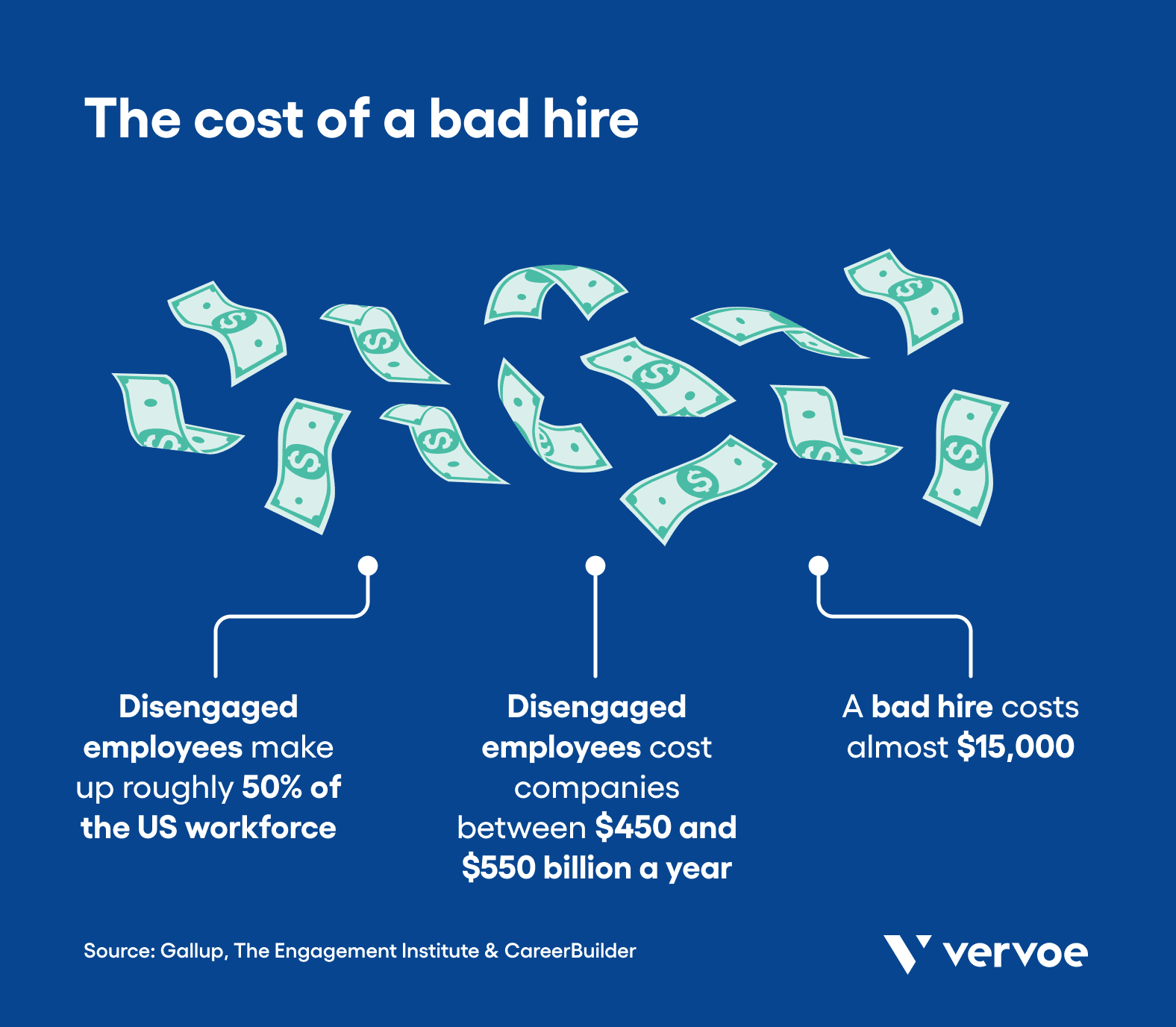
6. Job simulations help you quickly identify top performers
Last but certainly not least (in fact, we’d argue this is potentially the most critical point): An AI-based recruitment platform, like Vervoe’s, allows you to identify your top-performing candidates much faster than traditional recruitment methods.
Why exactly does this matter so much? Unfortunately, organizations can’t afford to waste time and money re-hiring, which means it’s important to identify top performers as quickly as possible, and to get it right the first time.
Unlike traditional recruitment methods that are often long-winded and time-consuming, AI-assisted job simulations are quick, effective, and accurate. For example, Vervoe’s AI can assess and rank 10,000 candidates in the same time it takes for recruiters to assess one applicant. This gives organizations an obvious competitive advantage, being able to (a) validate the candidate has the skills they need and (b) act fast to secure their contract before someone else does.
Final thoughts
Hiring skilled candidates takes time and effort. In the existing market, they’re few and far between, while competition continues to rise. Knowing what skills to look for, what a successful candidate looks like, what your organization needs, and how to assess all of the above is the primary challenge many hiring managers face.
The cost of leaving a position unfilled for an extended period simply cannot be ignored, nor can the financial burden of hiring the wrong person. The complexities of hiring today encourage many organizations to take a more pragmatic approach to ensure the best possible hires: job simulations.
The shift towards job simulations has shown many organizations where there are noticeable gaps in traditional worldwide recruitment solutions — inaccuracies, lengthy processes, and an inability to predict performance accurately.
An AI-based recruitment platform like Vervoe offers a versatile and efficient recruitment method that allows hiring managers to easily identify their top performers in minutes while giving candidates a realistic job preview. The cherry on top? Our intuitive machine learning AI grades automatically and ranks candidates efficiently and accurately to help you hire with confidence.
Does this sound like exactly what you need? Book a demo now and let our experienced team run you through Vervoe’s full range of ready-made and tailored solutions.




















